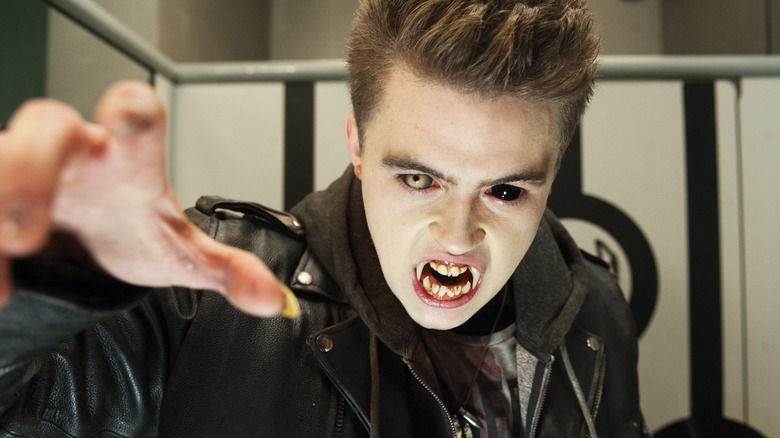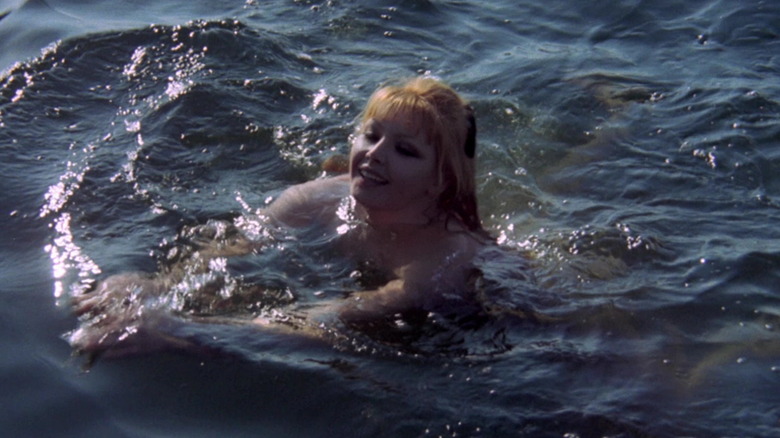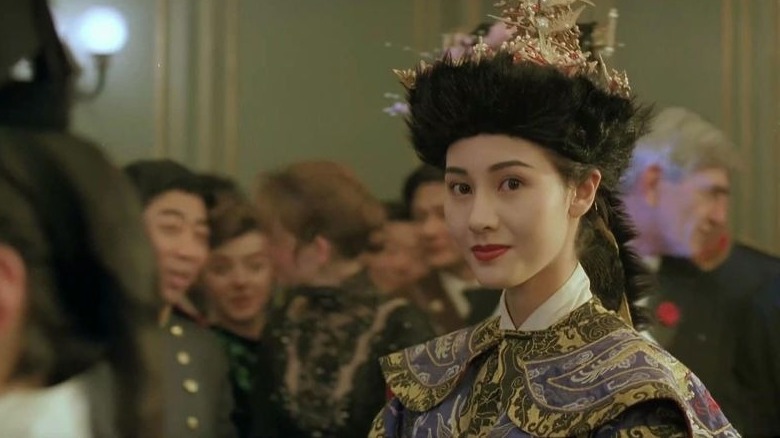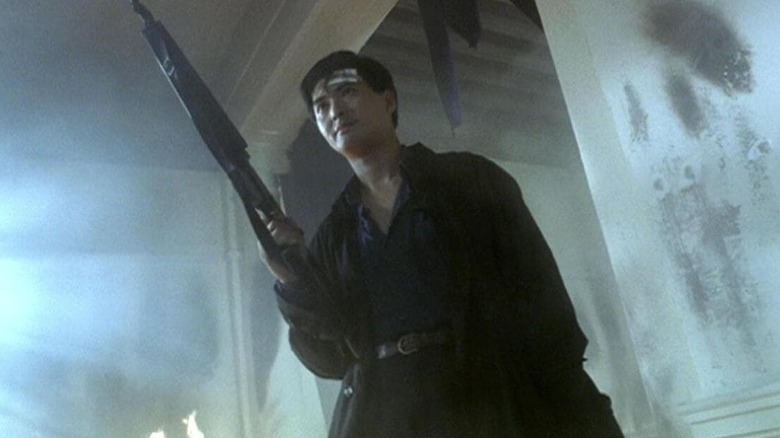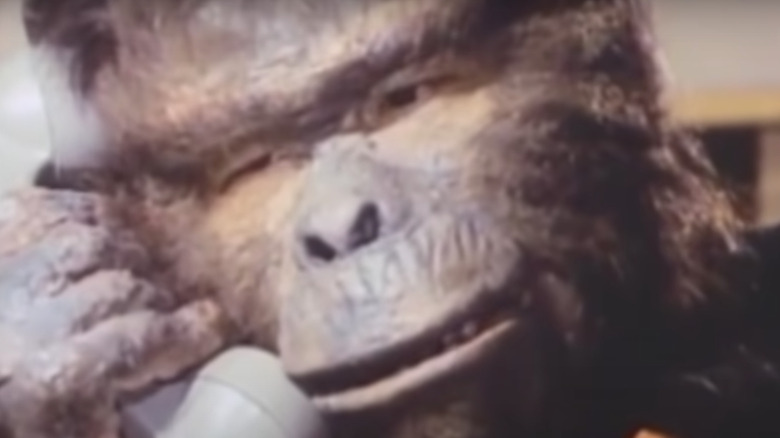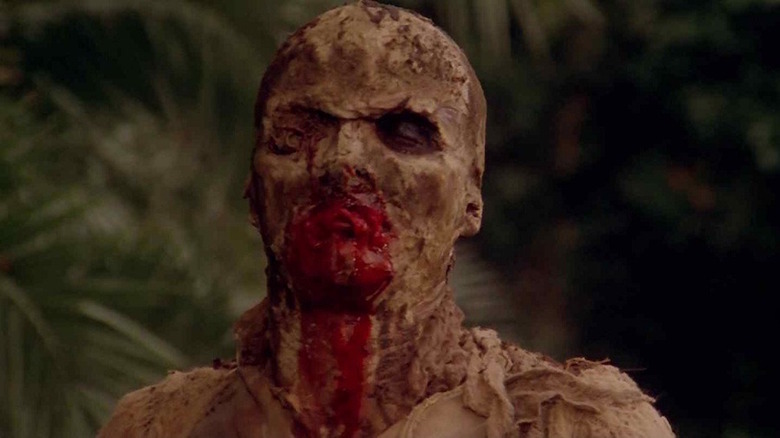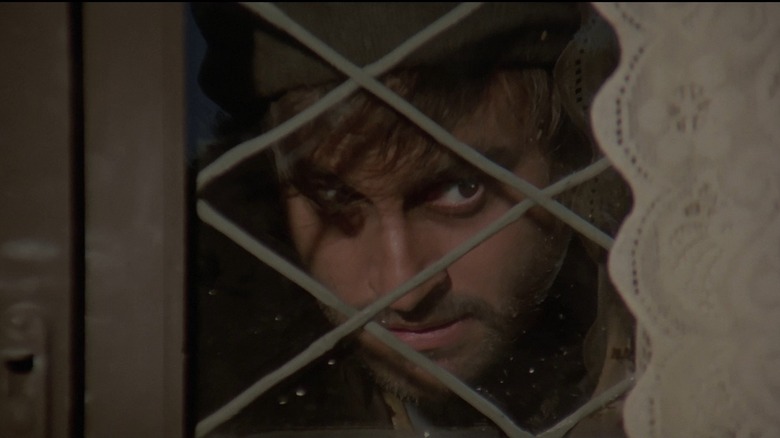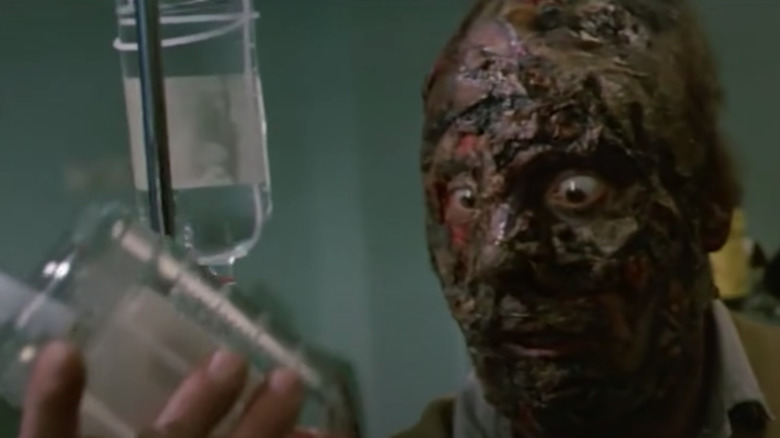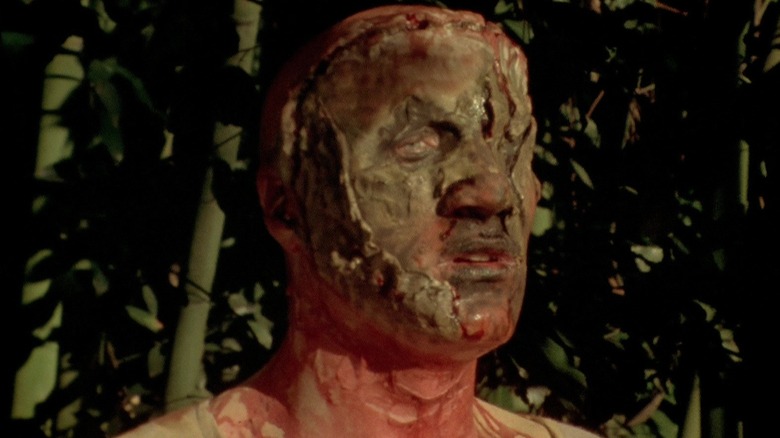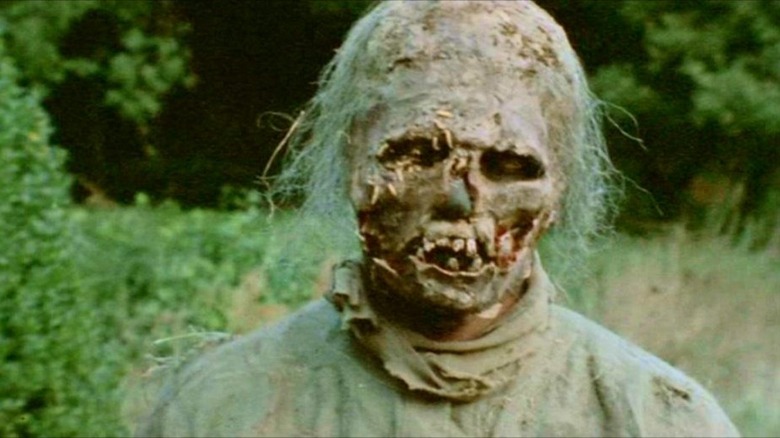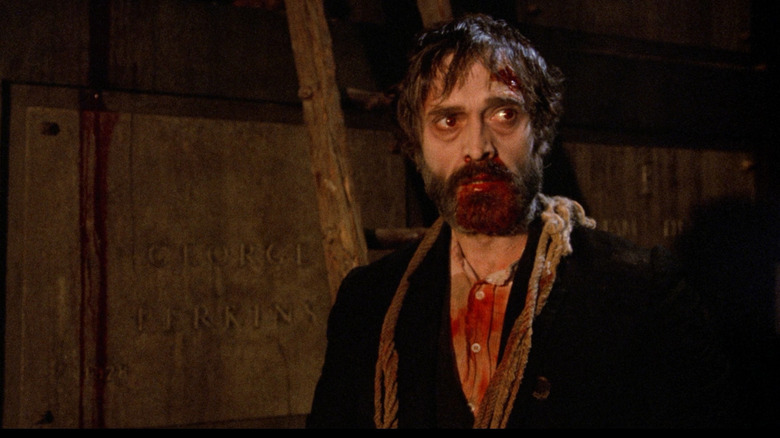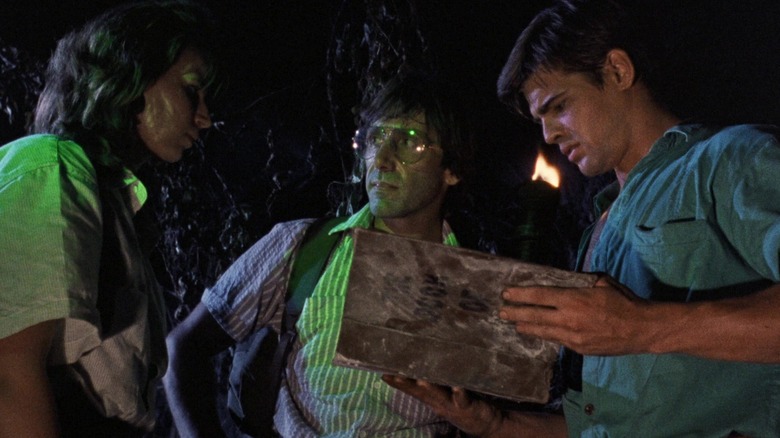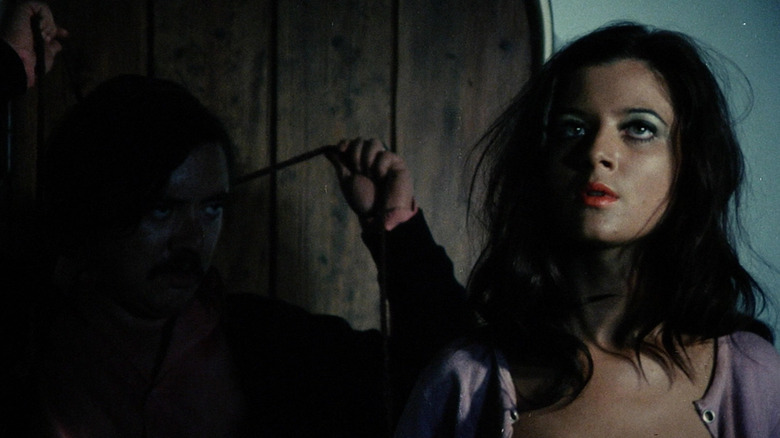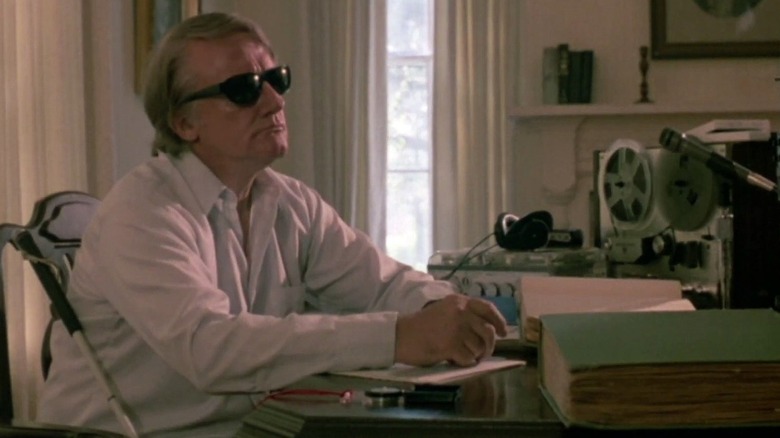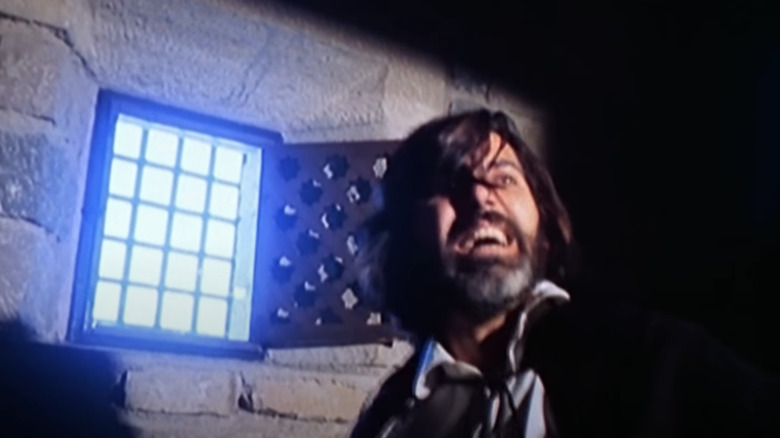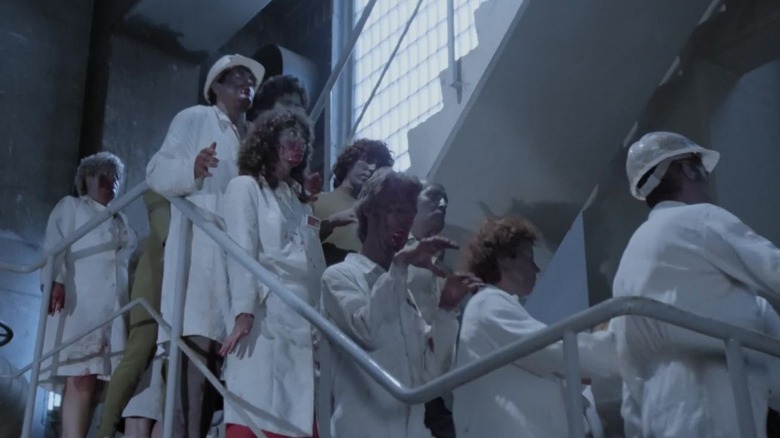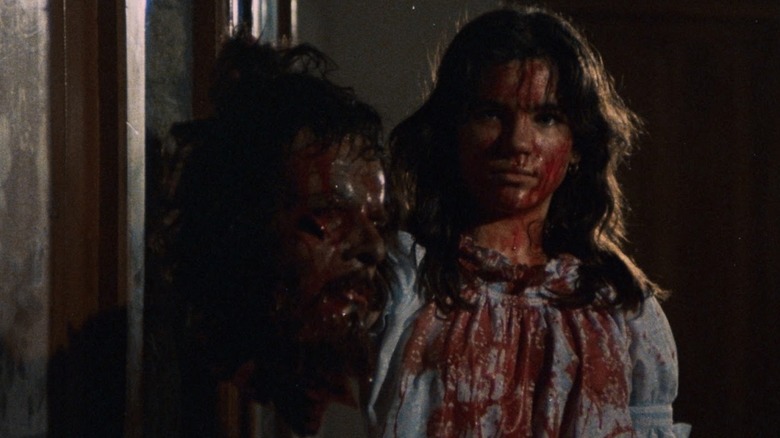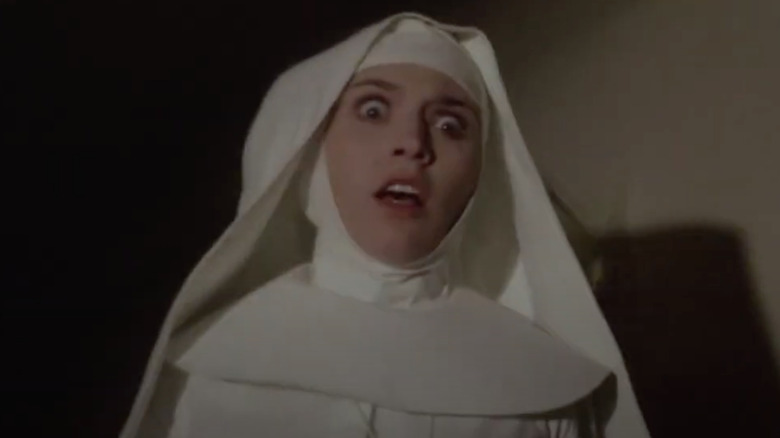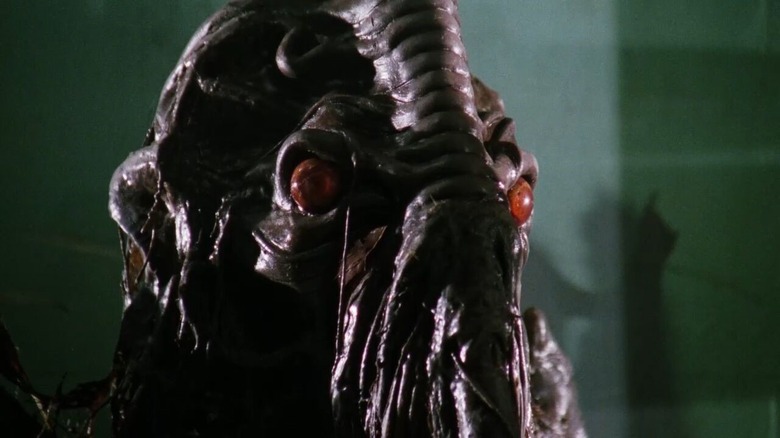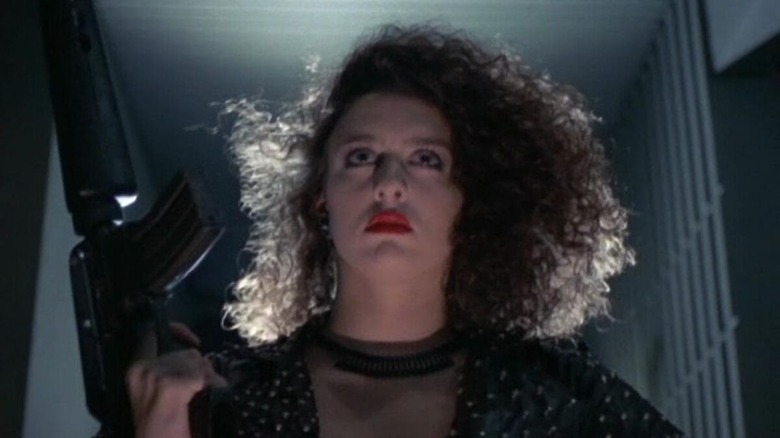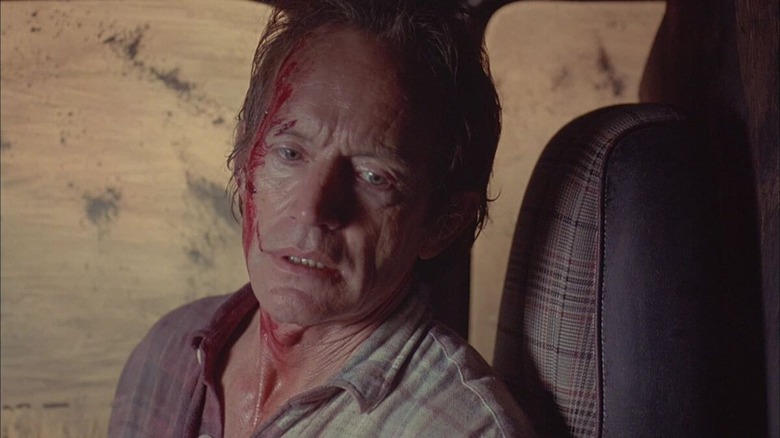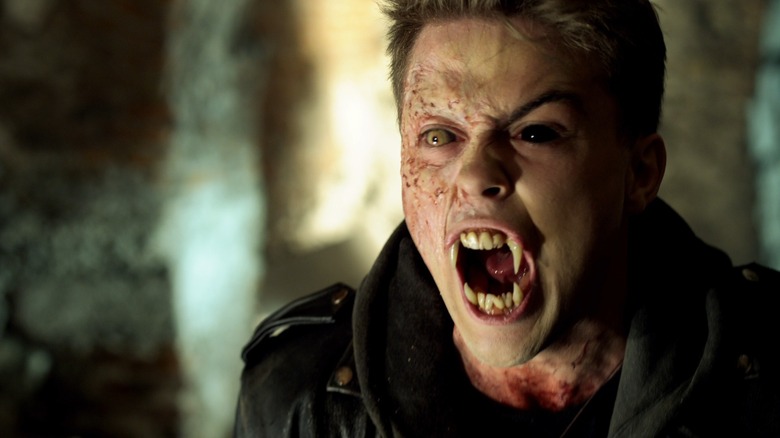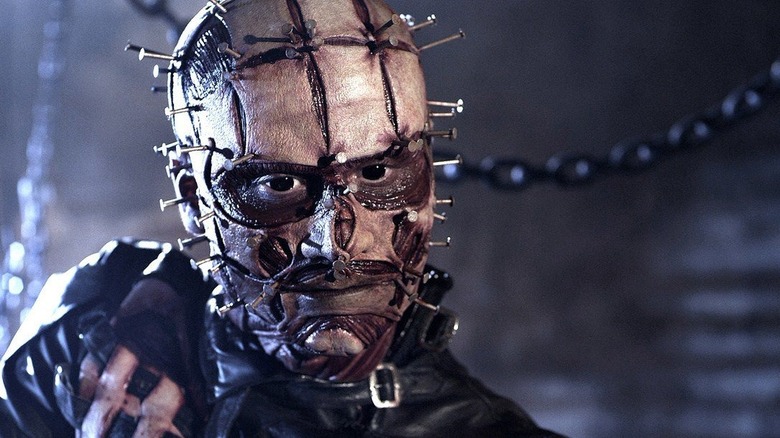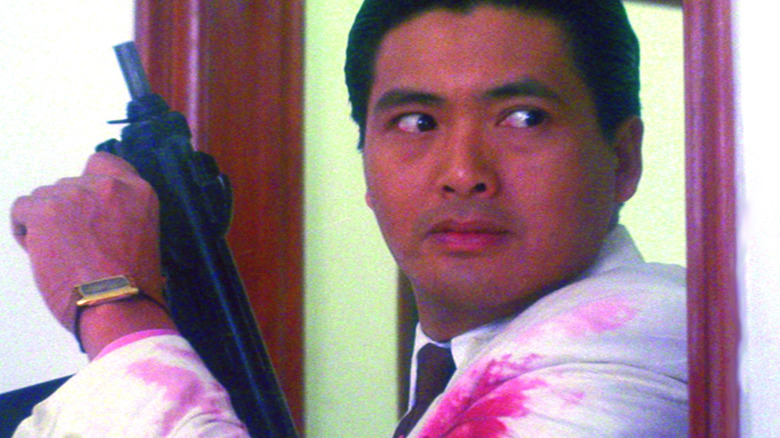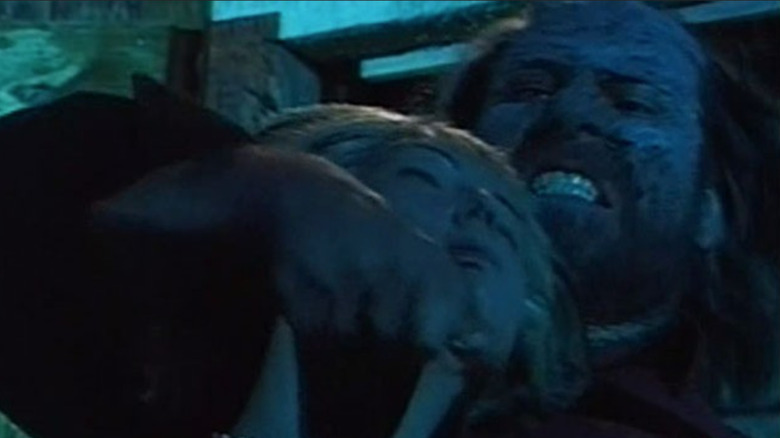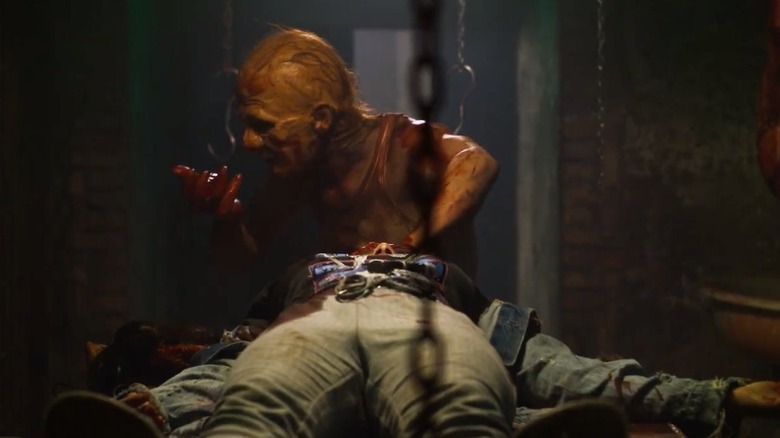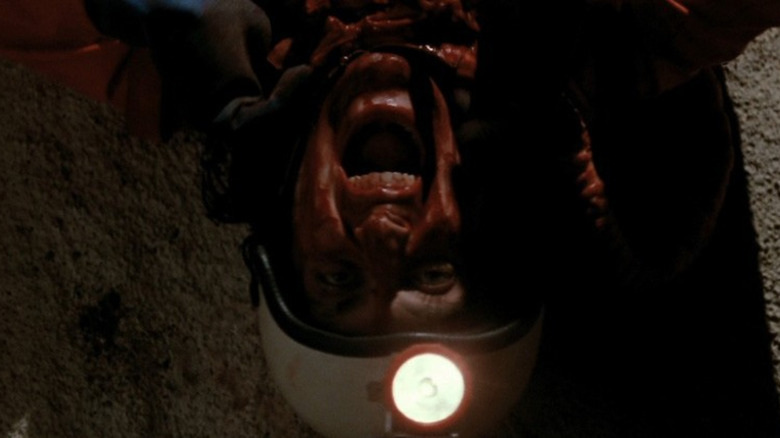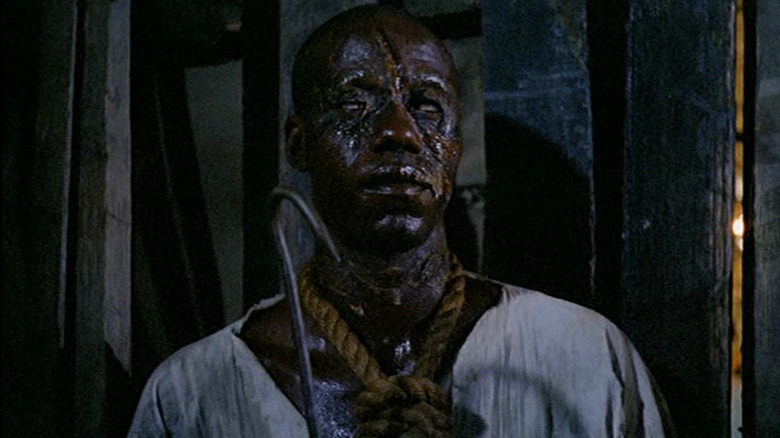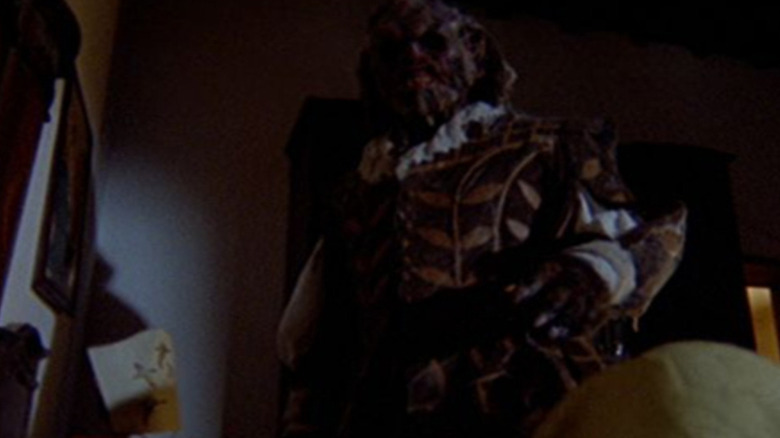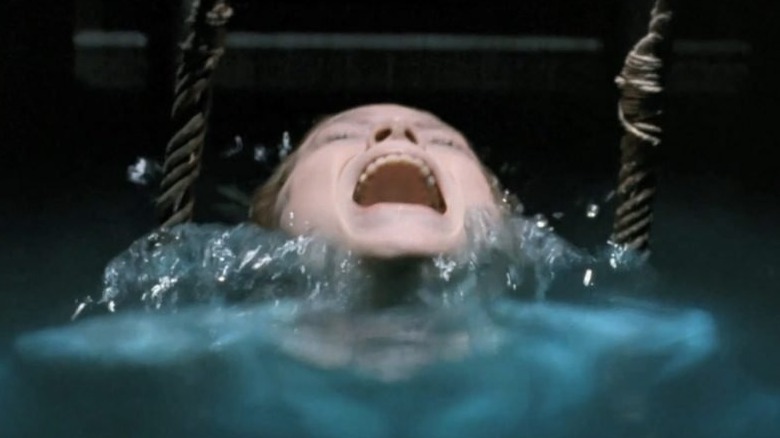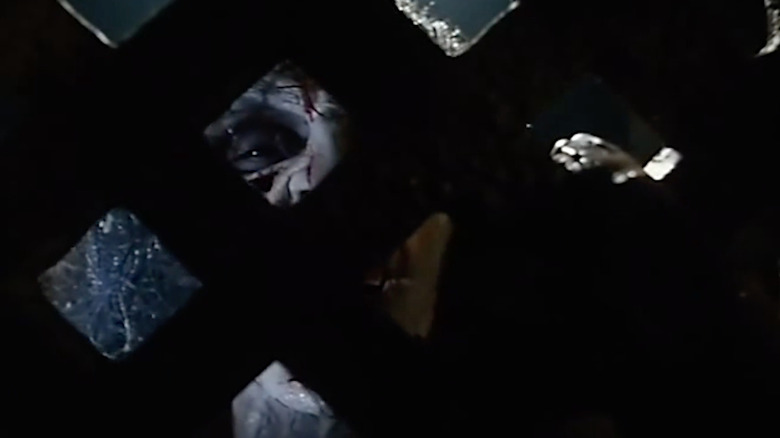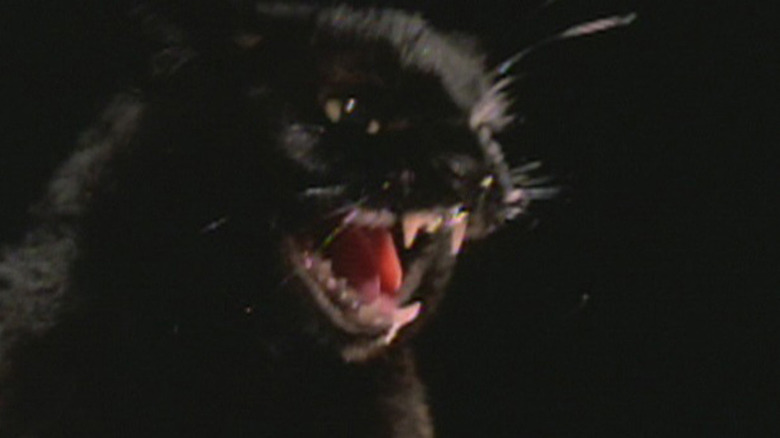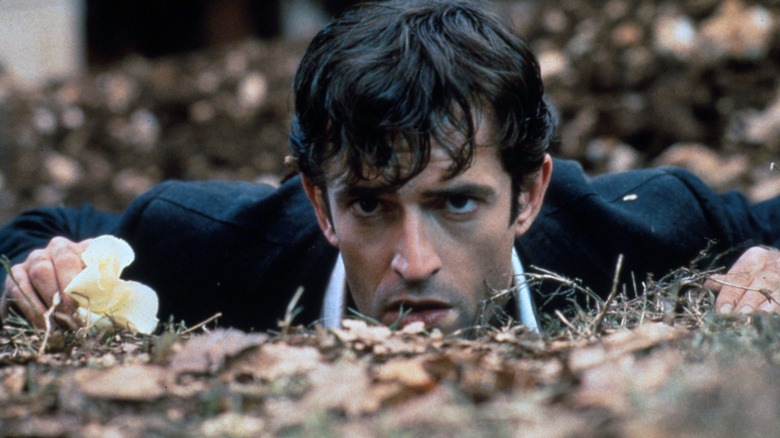Unrelated Movies That Pretended To Be Sequels To Popular Films
Popular, financially-lucrative movies often lead to a sequel or an entire series. Subsequent films are usually made by at least some of the same members of the original creative team, and almost always continue the ongoing storylines and journeys of the main characters. But sometimes, sequels defy these conventions — or even push moral and/or legal boundaries.
Fake, unauthorized sequels might be a rarity these days, but they do still slip by from time to time; a few decades ago, they were far more prevalent in certain markets. For a subset of particularly sleazy filmmakers and producers unconcerned with the ethical implications, stealing the title of a popular movie and pretending to be a sequel was an easy way to make a quick buck. Presenting their movie as a sequel became an underhanded tactic to sell their movie to wider markets, tricking fans of the original into checking out an unrelated cash grab. Italian horror films of the '70s and '80s were especially egregious in this regard, masquerading as sequels to box office hits. Below, some of the most notorious films that pretended to be sequels to movies they had nothing to do with.
Last House on the Left — Part II
Wes Craven is one of the undisputed masters of horror. When his debut film, "The Last House on the Left," hit theaters in 1972, he found considerable success right out of the gate and immediately put himself on the map. Soon after, another movie began doing the rounds as "Last House on the Left — Part II" despite having nothing to do with the first film and being made by a completely different group of people on the other side of the world.
This phony sequel sometimes went under the title "New House on the Left." Before this unscrupulous rebranding, the film had actually been already released, a year before "Last House on the Left" played Italy. The movie's real title has been in a constant state of flux since the beginning ("Twitch of the Death Nerve," "Ecology of Crime," "Carnage," and more), but they're all just alternate titles of a Mario Bava film most commonly called "A Bay of Blood."
Bava was one of the biggest names in Giallo, a highly-stylized sub-genre of Italian slasher-mystery movies. Even though its official title is tricky to pin down, "A Bay of Blood" is regarded as one of Bava's best, and would become influential within the genre.
Drunken Master III
1978's "Drunken Master" was one of the films that helped establish Jackie Chan as a superstar within the Hong Kong kung fu film industry. Yuen Woo-Ping directed the film, but did not return for the sequel, which hit theaters many years later in 1994. In many ways, "The Legend of the Drunken Master" surpassed the original, but there was major conflict behind the scenes. The new director, Lau Kar-Leung (AKA Liu Chia-Liang), was fired partway through production by Chan, who then took over as director for the rest of the shoot.
Kar-Leung didn't take his dismissal lying down. He went into production on "Drunken Master III," craning it out so fast that the film hit theaters the same year as "Legend of the Drunken Master." But regardless of the title, the film is not a sequel to either of the Chan-led movies and was simply trying to steal some franchise thunder.
The plot of "III" is unrelated to the other movies, following an almost completely different group of characters. Chan's character, Wong Fei-Hung, is peripherally involved, but his prominence in the story has been reduced and recast with Willie Chi, who was not a star and had only appeared in one movie beforehand. As if the other alterations weren't severe enough, "Drunken Master III" doesn't even incorporate the iconic drunken boxing fighting style into the plot in a worthwhile way, instead only jamming it awkwardly into a brief sequence out of obligation.
A Better Tomorrow III
The first two "A Better Tomorrow" movies were released back-to-back in 1986 and 1987 and helped put director John Woo on the map as the king of the bullet opera. Woo and fellow Hong Kong action maestro Tsui Hark produced both films together, and Hark joined the team of writers for "A Better Tomorrow II" as well. The two were a successful team in the Hong Kong film industry but were known to constantly bicker and fight behind the scenes. By the time "A Better Tomorrow II" was finished, a rift had formed between Woo and Hark that was large enough to end their working relationship and send them in different directions.
"A Better Tomorrow" was planned as a trilogy, but when the two producers split, the legacy of the series became a tangled mess. As the slightly more powerful and established of the two at the time, Hark kept control of "Better Tomorrow" name, delivering a trilogy conclusion without Woo's participation.
"A Better Tomorrow III" is a prequel, set before the events of the first film. Chow Yun-Fat again plays the lead character, but the rest of the cast gets swapped out, and the plot and themes of Woo's movies and his plans for a third all were left by the wayside.
One year later, Woo put out what he intended to be the conclusion of the trilogy. Since he no longer had the rights to his own "A Better Tomorrow" movies and the characters within them, he instead titled his movie "Bullet in the Head" and created a new group of characters, all serving as surrogates for his original protagonists.
The Apocalypse of the Planet of the Apes
The original "Planet of the Apes" film from 1968 is an Oscar-nominated classic that spawned a long line of sequels, multiple remakes, and remake sequels. It also inspired a number of copycats and imitators, such as 1987's "Time of the Apes" — which graduated from imitation to outright faux-sequel when it was released in Spain as "Apocalypse of the Planet of the Apes."
Now following the same naming convention as official franchise sequels ("Conquest of the Planet of the Apes," "Battle for the Planet of the Apes," etc), this un-Timed release was looking for a quick cash grab. Suffice it to say, the film does not deserve a legit spot in any "Apes" marathons.
"Apocalypse of the Planet of the Apes" steals the premise of the franchise, following a small group of humans who find themselves in a future where humanoid apes rule Earth. The movie was a Japanese production, and was actually cobbled together from old episodes of the 1974 TV series "Saru no gundan," itself just a TV knock-off of "Planet of the Apes." Is it possible to be a double rip-off? "Apocalypse" is so shameless that it might have faced trouble in copyright court if it hadn't been so thoroughly rebuked and instantly forgotten upon release. These days, it has a minor legacy as an infamously terrible movie, largely because of its placement in an episode of "Mystery Science Theater 3000."
Zombi 2
The most notorious fake sequel of all time might be "Zombi 2." George A. Romero's hit "Dawn of the Dead" was released in Italy a year before it reached theaters in the U.S. and the rest of the world, and In Italy the title was simply "Zombi" and it was sold as a standalone film, rather than the sequel to Romero's "Night of the Living Dead." Years later, Romero would continue his series with "Day of the Dead" — but in the meantime, his series was absolutely cannibalized by various Italian filmmakers who saw a hunger for undead content.
Italian horror legend Lucio Fulci made the first phony, unauthorized sequel with "Zombi 2," which hit theaters in Italy a year after Romero's hit. The two movies share no characters, no behind-the-camera personnel, no thematic, setting, or plot similarities whatsoever. But believe it or not, "Zombi 2" is a solid zombie movie on its own merits, packed with such memorable visuals as a zombie fighting a (real!) shark.
Lightning struck twice, as "Zombi 2" became a hit. Its success only further encouraged fake sequels — and fake sequels to those fake sequels. Fulci directed one legitimate sequel to this film in 1988, "Zombi 3," but every other movie in the series is a knock-off of a knock-off. If you aren't confused yet, don't forget that "Zombi 2" is also sometimes known as "Zombie," dropping its fake sequel pretense — and in Australia and the U.K., it was released as "Zombie Flesh Eaters."
Zombie 3: Return of the Living Dead
Long before "IP" was a Hollywood phrase, Italian filmmakers learned that cramming every recognizable word they could into an unrelated film's title could pay off financially. As such, "Zombie 3: Return of the Living Dead" is not a sequel to George A. Romero's "Zombi," nor is it a sequel to Lucio Fulci's "Zombi 2," nor is it even a sequel to Dan O'Bannon's "The Return of the Living Dead."
Originally titled "Orgy of the Dead," the film first hit theaters in 1973, predating two of the films it would purport to sequelize. The title was retroactively changed, of course, to capitalize on the buzz of the "Zombi" series, but the producers would ultimately prove to be every bit as imaginative in their titling as anything that was caught on camera. Hence, multiple releases of this particular film as "Beyond the Living Dead," "The Hanging Woman," "Beyond the Evil Dead" (after the success of Sam Raimi's "Evil Dead" movies) and even "Dracula, the Terror of the Living Dead" despite having absolutely nothing to do with Dracula.
Believe it or not, the actual film is closer to a "Frankenstein" knock-off that anything else, featuring a grave-robber named Igor. Audiences going in with hopes to see vampires and/or zombies were just as likely to encounter a cameo from Dolly Parton.
Zombi 3: Nightmare City
Another Italian horror flick with a large rotation of alternate titles, 1980's "Zombi 3: Nightmare City" was also released as everything from "Invasion of the Atomic Zombies" to "City of the Walking Dead." Or, you may have come across it as simply "Nightmare City," without the "Zombi 3" addendum.
The movie hit theaters one year after "Zombi 2," effectively capitalizing on the buzz of its faux-predecessor. The plot is a straightforward fight for survival against zombies, all in an attempt to escape from the titular nightmare city as the outbreak takes over. This time around, however, the zombies are created from nuclear radiation that enters the city via an airplane.
Even though the plot revolves around zombies, they do not behave like the mindless flesh-eating beings of the films that "Nightmare City" pretends to sequelize. Instead, these zombies are smarter and do far more than simply eating their victims. They are fast, they can operate machinery, and they use weapons like knives and even guns. The film stars Hugo Stiglitz, who received a bump in notoriety when Quentin Tarantino named a character after him in "Inglourious Basterds." "Zombie 3: Nightmare City" was directed by horror schlockmeister Umberto Lenzi, mastermind behind more than one fake sequel himself, and also a Tarantino favorite who inspired the "Grindhouse" zombie film "Planet Terror" with "Nightmare City." According to Tarantino, this film is also the first one to ever show zombies running.
Zombie 3 (1980)
Without any subtitle and released just a year after its supposed predecessor, "Zombie 3" seems like a more legitimate sequel than many of the other phonies out there, but it too is a fraud.
Before adopting a number, this fake sequel first called itself "Zombi Holocaust." It would cycle through dozens of alternate titles over the years: "Doctor Butcher M.D.," "Zombie Death Cult," "Queen of the Zombies," and "Anthropophage Holocaust: the Terror of the Zombies" included, just a few of the numerous titles the movie tried on for size to lure in viewers. The title was even changed to "Zombies Cannibal Ferox" at one point, in an attempt to cash in on the similarly schlocky appeal of "Cannibal Ferox" from none other than director Umberto Lenzi.
In spite of such shameless subterfuge, "Zombie 3" does bear a bit more in common with "Zombi 2" than the majority of its fake sequels. The film takes place on the same island location and reused some of the same sets — and it even features some of the same cast members, though they all play different characters in a completely unrelated plotline.
Zombie 3 — The Return of the Zombies
Lucio Fulci made the only fake sequel bearing the name "Zombi 2," but the same could not be said of the next movie in this twisted-beyond-recognition series. There was no shortage of directors and producers willing to throw ethical concerns out the window and brand their unrelated movies as an entry in the "Zombi" series for a shot at easy success. With Fulci not delivering the real "Zombi 3" until nearly a decade later, there was plenty of time for others to stake their claim on the title. By most accounts, there was somewhere in the neighborhood of a half dozen different movies that in some way purported to be "Zombi 3."
One of these was "Zombie 3 — The Return of the Zombies," sometimes known as "Burial Ground" and/or "The Nights of Terror." This time, zombies enter the plot when an archeologist accidentally releases them from a crypt. The rest of the film is spent watching the archeologist's friends fight and get killed by said zombies. The film was one of the more than 100 schlock movies written by Italian screenwriter Piero Regnoli, who sometimes churned out up to seven movies per year; that rushed writing process shows in the final product.
Zombie 3 (1974)
Another "Zombie 3" imitator, this one could actually be considered the best. Similar to "Zombie 3: Return of the Living Dead," this version of "Zombie 3" was originally released years before "Zombi 2," but had its title changed retroactively to cash in on the success of the series. Some horror fans may have originally come across this film by the title "Let Sleeping Corpses Lie" or "The Living Dead at Manchester Morgue."
While most of the fake "Zombi" sequels are trashy, easily-forgotten relics, "Let Sleeping Corpses Lie" has a sizable cult following and is a pretty solid zombie flick in its own right. As the "Manchester Morgue" alternate title implies, the film is set in England, even though the film was a collaboration between Spanish and Italian filmmakers. At the start of the movie, it plays like a sensationalized take on the Manson family murders, which had occurred just a couple years before the film was made. As the plot progresses, the true-crime setup gives way to a more traditional zombie story, however, where the deceased are reanimated by a dangerous new pest control measure. Though far from being a masterpiece, this is one fake sequel that might be worth a watch for hardcore zombie fans.
Zombie 4: After Death
Fulci returned with the only real "Zombi 3" in 1988. While this put the kibosh on all those other directors who were making their own versions of "Zombi 3," it also opened the door for them to start making fake "Zombi 4" movies instead.
The first of these was "Zombie 4: After Death," released just a year after "Zombi 3." In addition to pretending to be a sequel in the "Zombie" series, this movie pretended to be a sequel in the "Return of the Living Dead" series as well, going by the alternate title "Return of the Living Dead Part 3" — which meant it was boldly claiming to be the third entry in one series while simultaneously claiming to be the fourth entry in a completely different series.
"After Death" does involve the walking dead, like previous "Zombi" movies, but also jams a voodoo priest and a cure for cancer into its plot. The movie was directed by Claudio Fragasso, who would later co-write and directed "Troll 2," considered by some to be the worst movie ever made and itself a classic of enjoyably-bad sequel cinema. "Zombie 4: After Death" doesn't plunge to depths quite as low as "Troll 2," but is another nonsensical disaster of a movie.
Zombie 4: A Virgin Among the Living Dead
"A Virgin Among the Living Dead" was first released in 1973, long before the insanity of the fake "Zombi" sequels. Trying to scrounge up the tiniest bit of a financial win, the movie was re-released over and over again throughout the years, under titles like "Christina's Erotic Dreams" and "Christina, Princess of Eroticism." Some cuts of the film resemble a sexually-charged horror film, while other edits drop the pretense and present as straight-up softcore pornography.
After the success of the "Zombi" series, "Zombie 4" was tacked onto the front of this film's original title, as it hit video stores in the United States. But the film is set primarily in a gothic castle, and it's a haunted house story, with the main threat being malevolent spirits rather than any sort of zombified creatures. The movie was written and directed by Jesús Franco, who directed an incredible total of over 200 films in his lifetime, most of which were sleazy horror and/or erotica. Just as his films went by dozens of alternate titles, Franco himself was frequently credited under numerous pseudonyms, ranging from James P. Johnson to Lulú Laverne.
Zombie 5: Killing Birds
"Zombie 5: Killing Birds" was released in some territories as "Zombi 4: Killing Birds," and is one of the only examples of a movie pretending to be both the fourth and fifth entries in a series while being neither. Interestingly enough, this "Zombie 5" was released in 1988, the same year as the real "Zombi 3" and before any of the other fake "Zombi 4" imitators.
As the title hints, the threat for this trashy horror movie has far more to do with birds than the undead. Though it is an Italian production, the film is set in the United States and notable for starring Robert Vaughn, a household name in the '60s and '70s after "Bullitt," "The Towering Inferno," "The Magnificent Seven" and "The Man from U.N.C.L.E.," though his star power dwindled considerably by the time he signed on to do "Zombi 5."
Vaughn plays a soldier who murders his wife and her lover upon his homecoming from the Vietnam war. In this nonsensical plot, he is randomly attacked by a bird right after the double murder, losing one of his eyes. The film jumps forward in time, finding him now working as a bird expert and conducting research in the swamplands of Louisiana, which inexplicably leads to supernatural horrors.
Zombie 5: Revenge in the House of Usher
"Revenge in the House of Usher" is a cheapo Spanish horror from the prolific Jesús Franco, based loosely on the writings of Edgar Allen Poe. When the film was released in the United States, it was given the "Zombie 5" title despite having nothing in common with the "Zombie" series, perhaps only because Franco had directed one of the fake "Zombie 4" imitators.
Though not particularly faithful to the Edgar Allen Poe source material, "Zombie 5" also doesn't feature any zombies. The closest the film gets to zombies is with the main character's efforts to bring his deceased wife back to life, but she could hardly be called a zombie. The real danger of the film is the titular Eric Usher (Howard Vernon), who goes around murdering prostitutes and harvesting their blood in the hopes that it will heal his dead wife. There are also ghosts inhabiting the house of Usher that go mostly unexplained in the narrative.
Only part of "Zombie 5: Revenge in the House of Usher" consists of original material, with the rest of the movie being cobbled together from re-used footage out of Franco's earlier horror film "The Awful Dr. Orlof," one of the rare Franco films to earn its share of positive reviews. The same cannot be said of "Zombie 5."
Zombi 5: Ultimate Nightmare
Similar to "Zombie 5: Killing Birds," "Zombi 5: Ultimate Nightmare" also pretended to be both the fourth and fifth movie in the series at different times. And similar to "Zombie 4: After Death," "Ultimate Nightmare" was again directed by Claudio Fragasso, though this time he shared directorial duties with Bruno Mattei, who was no stranger to making fake sequels to popular movies.
The film also went under the titles "Hell of the Living Dead," "Night of the Zombies," "Zombie Inferno," and "Zombie Creeping Flesh." This time around, the action is set on the island of New Guinea, following two different groups of survivors trying to survive a zombie outbreak; one a French TV news team and the other a military squad. The news team is there to cover rumors of a dangerous lab-grown virus being used in experiments, which ultimately escapes beyond the lab and leads to the zombie carnage. The soldiers, on the other hand, just happen to be in the area on unrelated matters. While pretty silly and all over the place on a plot level, this version of "Zombi 5" at least delivers on zombie antics and gore — both of which can be oddly absent from other fake sequels.
Zombie 6: Monster hunter
The last of the fake "Zombie" sequels was "Zombie 6: Monster Hunter." Like many of the faux-sequels, this one has nothing to do with zombies or the living dead whatsoever.
It was first released in 1981, two years after "Zombi 2" and long before many of the other fake sequels in this pretzel-like series. The weird thing is that "Zombie 6" is a real sequel, just not in the "Zombie" series. The movie is actually a sequel to "Anthropophagus: The Grim Reaper" from one year earlier, a successful horror movie that received its fair share of fake sequels as well.
Also known as "Absurd," this stealthy "Anthropophagus" sequel re-teams writer/star George Eastman with director Joe D'Amato from the original movie. Eastman again plays the titular Anthropophagus, an immortal, super-strong serial killer with both cannibalistic and animalistic traits. The plot is pretty similar to the events of the first film, with the killer going on another bloody rampage. The key difference is that this time somebody is hunting him down too, in the form of the titular monster hunter. Even though the movie claimed to be "Zombie 6," D'Amato would eventually direct "Zombie 5: Killing Birds" several years later, inexplicably making his phony sequels out of order.
Return of the Exorcist
After first hitting theaters in Italy in 1975 under the title "A Scream from the Darkness," this film changed its name several times before settling on "Return of the Exorcist" and pretending to be a sequel to the hit American horror movie "The Exorcist" from 1973. After the real sequel, "The Exorcist II: The Heretic" was released in 1977, "Return of the Exorcist" was rebranded again as "The Exorcist 3: Return of the Exorcist" in Japan and Finland, and as "The Exorcist III: Cries and Shadows" in the U.K.
"Return of the Exorcist" might not be a real sequel, but it is a shameless knock-off of the original "Exorcist," copying much of its plot verbatim. Once again, a child becomes possessed by a demon, and a priest needs to come in and perform an exorcism. The possessed kid is made a bit older and male this time, but the biggest change comes in the way that he becomes possessed. Instead of the Ouija board from the original movie, the teenage boy becomes possessed when he unknowingly photographs a demon, which in this movie's confusing reality apparently leads to possession.
Terminator 2
James Cameron's original "The Terminator" from 1984 was another breakthrough hit that spawned a wave of imitators and knock-offs in its wake; of course, it also helped that a real sequel wouldn't arrive for another seven years.
During this window of opportunity, multiple copycats borrowed liberally from the ideas of time travel and killer robots, a few even going so far as to claim to be direct sequels. The most egregious was "Terminator 2," released in 1989, two full years before James Cameron created the real sequel, "Terminator 2: Judgement Day." Even the film's poster art was designed to mimic the original film's poster, just another effort to trick unsuspecting moviegoers into thinking they were paying for a legitimate sequel.
This fake "Terminator 2" is set in a vaguely futuristic Venice, Italy and features not only a Terminator killing machine but also goopy horror monsters that look unlike anything in the real "Terminator" movies. "Terminator 2" was directed by Bruno Mattei and co-written by Claudio Fragasso, both intimately familiar with the fake-sequel grift already, thanks to the "Zombi" series.
The fake "Terminator" sequels didn't stop there, however. Plenty of other filmmakers attempted to cash in on the series' name recognition, one of the most misleading being 1989's "Russian Terminator," which is about a ninja and doesn't actually feature anything even close to resembling a Terminator. Even the Russian part of the name was misleading; the film was actually shot in Sweden by an entirely Swedish and Danish production team.
Lady Terminator
The outright zaniest fake "Terminator" sequel was arguably "Lady Terminator," released in between Cameron's first two "Terminator" movies. Made in Indonesia and not involving a Terminator or any other kind of robotic or cybernetic character, the titular "Lady Terminator" is actually an anthropologist who becomes inexplicably possessed by an ancient queen of the sea.
The plot starts out as ridiculous and only goes further off the rails as it moves along, to the point where the lady Terminator is melting and shooting lasers from her eyes. The only faint resemblance to "The Terminator" arrives when she dons a leather jacket and goes around shooting random people. The film's original title, which translates directly to "Revenge of the Queen of the South Coast," is a more apt description of the film, but it became known as "Lady Terminator" throughout most of the world. In some countries, the movie was released under the title "Nasty Hunter"; in others, it landed on video as "Shooting Star." The most ridiculous but fun title, however, was saved for the Japanese video release: "Snake Terminator: The Snake Wench Dies Twice."
The Hills Have Eyes Part 3
Wes Craven wrote and directed the first two "The Hills Have Eyes" movies; Alexandre Aja would eventually remake Craven's original, and that remake got its own sequel. But in between Craven's originals and the remake duology, another film came along that somewhat masqueraded as a third entry in the series — because it at one point had been designed to be exactly that.
Titled "The Outpost," then eventually "Mind Ripper," the film was also known in the U.S. and Germany as "The Hills Have Eyes Part 3," "The Hills Have Eyes III: Mind Ripper," and perhaps boldest of all, "Wes Craven's The Hills Have Eyes 3." But before you start crying intellectual property theft, know this: The film was written and produced by Jonathan Craven, Wes Craven's real-life son. Wes receives an executive producer credit, and in some territories it was released as "Wes Craven Presents: Mind Ripper." This is because "Mind Ripper" was originally conceived as a third "Hills Have Eyes" movie, until things went south.
"Wes executive produced for his old friend Peter Locke's company (he was the producer of the original 'The Hills Have Eyes films)," the younger Craven would write years later in the book "Screams for a New Millennium." "The original concept was to make a 3rd edition... I wanted to make something gritty, dark and youth-oriented as an homage... Peter had another agenda... his heart set on creating a horror franchise built around a 'brain-sucking' monster... my heart was never quite into [it]."
Fright Night 2
1985's "Fright Night" was written and directed by Tom Holland, who later created the iconic killer doll Chucky with the original "Child's Play." "Fight Night" was his first hit, and the movie received a direct sequel a couple of years later with 1988's "Fright Night Part 2." This was a legitimate sequel, one that continued the story and brought back the main characters of the original.
Fast-forward a few decades to 2011, when "Fright Night" was remade by "Lars and the Real Girl" filmmaker Craig Gillespie, starring Anton Yelchin, David Tennant, Toni Collette, Imogene Poots, Dave Franco, Christopher Mintz-Plasse, and Colin Farrell fleshing out the main cast. The remake was a box office bomb and never received a real sequel, but it did receive a straight-to-video pseudo-sequel two years later with "Fright Night 2: New Blood."
The A-list cast was replaced entirely with unknowns, and the plot made no attempt to even continue the storyline of the previous movie. Instead, "Fright Night 2" is just another remake of the original "Fright Night," this time with a drastically lower budget and worse actors. Even characters that were turned into vampires and/or killed in the first movie are reset to their original starting point this time — just so they can be turned and killed again.
Hellraiser: Revelations
With an excellent first film and a decent second one, the "Hellraiser" series could have gone out with a pretty solid reputation after "Hellbound: Hellraiser II." Instead, the series kept going on and on, reaching a total of 10 mostly-terrible, mostly straight-to-video entries before being rebooted in 2022.
One of these supposed sequels, however, stood out from the rest in that it was so bad that Clive Barker — writer of the original "The Hellbound Heart" source material and writer/director of the original film — was compelled to put out a public statement denouncing it after his name was listed in the credits. "I want to put on record that the flick out there using the word Hellraiser IS NO F**KIN' CHILD OF MINE!" he tweeted (via Dread Central). "I have NOTHING to do with the f**kin' thing."
The fake sequel went by the name "Hellraiser: Revelations," and was made in 2011 by Victor Garcia, director of straight-to-video horror sequels like "Mirrors 2" and "Return to House on Haunted Hill." "Revelations" features familiar elements from the series, like the cenobites and the puzzle box, but has little else in common with the series. It was also the first movie in "Hellraiser" history to recast Doug Bradley as Pinhead. Supposedly, the movie was conceived and shot in a total of just two weeks, as a ploy for the studio to avoid losing rights to the property. That near non-existent pre-production timeline shows in the end result.
Killers Two
One of John Woo's best movies was his 1989 shoot 'em up flick "The Killer" (pictured above). The film is a two-hander, featuring an assassin (Chow Yun-Fat) and the police officer trying to catch him (Danny Lee), as a sense of mutual respect and friendship blossoms between them. Yun-Fat and Lee had acted together a couple of times in the preceding years, and their earliest collaboration would receive a rebrand, positioning itself as a sequel under the title "Killers Two."
Woo's "The Killer" and "Hard Boiled" were two of the first Hong Kong Heroic Bloodshed movies to break through to audiences in the U.S., and home video distributors leapt at the chance to capitalize on this new popularity by re-releasing older Hong Kong action movies with fake sequel titles. "Killers Two," originally released several years before "The Killer" as "The Executor" and "Heroic Cops," attempted to lure in American fans of "The Killer" as a sequel in U.S. video stores under the title "Killers Two."
The film's description was changed for the U.S. VHS release to explicitly call itself a sequel, even cribbing stills from other John Woo movies. Such deceptive practices, unfortunately, were a common occurrence in video stores at the time. One of Yun-Fat's earliest action movies was similarly retitled "Hard Boiled Killers," mashing together the titles of his two most popular films.
Anthropophagous 2000
Released in 1999, "Anthropophagous 2000" purports to be a sequel to "Anthropophagus" from 1980, though the spelling of the title was changed, perhaps accidentally since a high level of effort cannot be found in anything else surrounding this production. The original "Anthropophagus" received a legitimate sequel one year after its release, which was itself a fake sequel as it claimed to be a part of the unrelated "Zombi" series. The film was a straightforward pseudo-slasher flick about an immortal, cannibal serial killer murdering a bunch of tourists in the most graphic, gory ways possible.
Hitting theaters almost 20 years after the original and featuring none of the same cast or crew, "Anthropophagous 2000" is a cheap, sleazy German production set in Austria as opposed to the original, which was a cheap, sleazy Italian production set in Greece. With virtually the same exact plot (an immortal cannibal killer takes out a bunch of friends), the movie is closer to being an unauthorized remake than it is a sequel. The movie was shot on video for a tiny budget, clocks in at only 80 minutes (even with drawn-out credits), and is the definition of a disposable exploitation cash grab.
Anthropophagus II
Completely unrelated to "Anthropophagous 2000," "Anthropophagus II" claims to be a direct sequel to the original "Anthropophagus: The Grim Reaper" from 1980. This fake sequel ignores the official sequel from 1981, "Absurd," and aims to take its place, though it of course has no legitimate connection to the series.
Instead of the lush Greek island setting of the original, "Anthropophagus II" is set primarily inside a nuclear fallout bunker. A group of women are challenged to spend 24 hours in the bunker by their college professor, but they, unsurprisingly, become trapped inside with the anthropophagus, who mutilates and eats them. The makeup design for the anthropophagus looks nothing like the previous movies, and it's not the only thing that has a faint resemblance.
Given that the original "Anthropophagus" is a rather obscure exploitation flick without much IP appeal these days, it might come as a shock to learn that this fake sequel was released straight to video as recently as 2022. Over 40 years later, the original trashy horror movie is still receiving phony cash-grab sequels.
Alien 2: On Earth
"Alien 2: On Earth" is a phony sequel to Ridley Scott's sci-fi horror masterpiece "Alien." This Italian knock-off was shot fast and cheap, and released just a couple months after the original movie and a full six years before James Cameron eventually delivered the real sequel with "Aliens" in 1986.
The director, Ciro Ippolito, was proud of his unscrupulous quick thinking and considered the sequel to be fair game since he beat them to the punch. He told the Italian news outlet Corriere del Mezzogiorno, "The incredible thing is that they weren't able to make "Alien 2" because I had made it in the meantime. They had to do "Aliens." With the S." 20th Century Fox tried to sue Ippolito for copyright infringement over the fake sequel, but he won in court.
As the subtitle implies, "Alien 2: On Earth" moves the action from outer space to planet Earth, which undoubtedly made the movie significantly easier to pull off with its low budget trappings; it also stripped away pretty much any resemblance to the original movie. The bulk of the film takes place in a system of caves, and instead of the iconic Xenomorph designs from the original film, "Alien 2" mostly finds the aliens possessing human bodies, meaning they just look like normal people most of the time. The aliens do eventually burst out of their human hosts in gory fashion, similar to the chest-burster from the original, but they lack the distinctive H.R. Geiger art design and instead resemble standard horror movie monsters.
Demoni 3
Other than the "Zombi" series, the Italian horror series with the most contorted lineage is undoubtedly the "Demoni" series, also known as the "Demons" series.
The original "Demons" that kicked it all off was released in 1985, from director Lamberto Bava and co-writer/producer Dario Argento, one of the most influential figures in Italian horror. The titular demons are basically just zombies by a different name, and "Demons" features virtually no plot beyond locking a bunch of random people in a movie theater to be torn apart for 90 minutes. The non-stop gorefest was a surprise hit and led to all manner of fake sequels. The film received one legitimate sequel the following year — and a whole bunch of faux sequels afterwards.
"Demoni 3," also known as "Black Demons," hit theaters in 1991 and had absolutely nothing to do with either of the movies it claimed to sequelize. The film is set on a plantation in Brazil, where voodoo is used to create a horde of zombies. The movie was directed by Italian filmmaker Umberto Lenzi, who also made the fake sequel "Zombi 3: Nightmare City."
Demons 3: The Ogre
"Demons 3: The Ogre" is a bizarre case of a fake sequel actually being made by the director of the original movie. Lamberto Bava made "The Ogre" as a TV movie in 1988. It aired on Italian and French television as simply "The Ogre" or "The House of the Ogre." To give the movie a bit more name recognition, "Demons 3" was plastered in front of "The Ogre" when it was released in most of the rest of the world.
Even though "Demons 3: The Ogre" was made by the same team of Lamberto Bava and screenwriter Dardano Sacchetti, who made both of the two legitimate "Demons" movies, they were in no way attempting to make another sequel with "The Ogre;" that misleading rebranding came later on. The movie has nothing to do with demons, zombies, or anything else from the "Demons" series. If anything, the film is closer to being a remake of "Zombi 2" director Lucio Fulci's "The House by the Cemetery" from 1981, which was also co-written by Sacchetti. Both are about American families who move into new houses and are terrorized by assorted supernatural happenings.
Demons 4
"The Sect" is an Italian horror film from 1991 about a satanic cult tormenting a kindergarten teacher — played by Kelly Curtis, the older sister of Jamie Lee Curtis — and unleashing supernatural evils. For some inexplicable reason, the film was rebranded "Demons 4" despite not featuring zombies, or demons, or having anything in common with the series at all. The only slight linkage between "Demons 4" and the roots of the series was the involvement of Dario Argento as one of the film's three screenwriters, but the movie he co-wrote was called "The Sect" and didn't become a fake sequel until later on.
The strangest detail about this phony "Demons 4" is that it was directed and co-written by Michele Soavi, who was originally supposed to direct the legitimate "Demons 3." The real "Demons 3" never came to be, with Soavi instead re-tooling the premise of the work-in-progress and releasing it as "The Church," meaning that every version of "Demons 3" is a fake. Even though he blew up his chance to make a legitimate entry in the series, he ended up making a fake sequel instead just a couple of years later. Soavi's next movie was another fake "Demons" sequel, too.
Demons 5: The Devil's Veil
The original director of the first two "Demons" movies, Lamberto Bava, returned to the series with "Demons 5: The Devil's Veil." Except, Bava actually made an unrelated TV movie called "The Mask of Satan," and the "Demons 5" title was just plastered onto it afterward. The movie aired as an episode of the Italian horror anthology television series "Sabbath" and, as you might expect, it has absolutely nothing to do with zombies or demons. Instead, it is about a group of skiers who fall into an icy chasm and accidentally awaken a witch that has spent centuries in a sort of frozen hibernation.
"Demons 5" has no connection to the "Demons" series despite sharing the title and the same director, but the movie does have a strong connection to another hugely successful Italian horror film. "The Mask of Satan" is a loose remake of the film "Black Sunday," which was made by Lamberto Bava's father Mario Bava almost 30 years earlier.
Demons 6: De Profundis
"Demons 6: De Profundis" is a 1989 horror movie from Italian filmmaker Luigi Cozzi, who was known for making cheap rip-off movies like "Little Wizards of Oz" and the 1977 Italian "Godzilla" knock-off that repurposed and colorized footage from the original black and white Japanese movie. "Demons 6" was no less shameless than his other movies and, of course, had nothing to do with the prior "Demons" movies.
"Demons 6: De Profundis" is also known as "The Black Cat" or "Edgar Allen Poe's The Black Cat." Though it certainly takes plenty of liberties with the source material, the "Black Cat" title is far less of a stretch than the "Demons 6" title, as it does generally resemble a sleazier and more gratuitous version of Poe's original short story. The only slight connection to the original "Demons" was the presence of actor Urbano Barberini in both movies, though he plays completely unrelated characters and the stories couldn't be more different.
Demons '95
"Demons '95" is another unrelated Italian horror that claimed to be a part of the lucrative "Demons" series, but this one at least had a little bit more in common with the original movies than many of the phony sequels. For one, it was actually about zombies (or demons) again, which most of the fake sequels didn't bother with. Secondly, Michele Soavi was back in the director's chair, the same filmmaker who made the fake "Demons 4" but, more importantly, the man who was supposed to direct the legitimate "Demons 3" until that project fell apart.
The most surprising part of "Demons '95" is that it is a solid zombie movie on its own merits, and has a cult following to this day. The film is better known by the titles "Dellamorte Dellamore" or "Cemetery Man." British actor Rupert Everett stars as the groundskeeper of an Italian cemetery, where he is tasked with re-killing the deceased as they routinely return to life. Setting aside the shady subterfuge of pretending to be a "Demons" sequel, this is one of the rare fake sequels actually worth your time.
